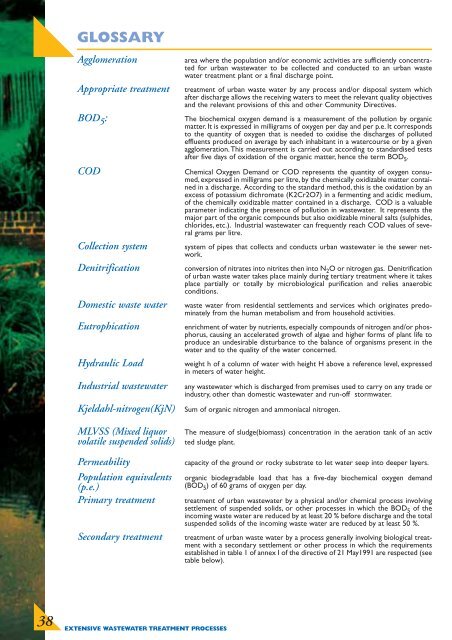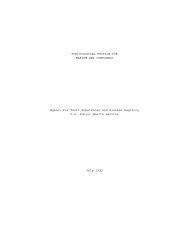Guide Extensive wastewater treatment process
Guide Extensive wastewater treatment process
Guide Extensive wastewater treatment process
You also want an ePaper? Increase the reach of your titles
YUMPU automatically turns print PDFs into web optimized ePapers that Google loves.
38<br />
GLOSSARY<br />
Agglomeration area where the population and/or economic activities are sufficiently concentrated<br />
for urban <strong>wastewater</strong> to be collected and conducted to an urban waste<br />
water <strong>treatment</strong> plant or a final discharge point.<br />
Appropriate <strong>treatment</strong> <strong>treatment</strong> of urban waste water by any <strong>process</strong> and/or disposal system which<br />
after discharge allows the receiving waters to meet the relevant quality objectives<br />
and the relevant provisions of this and other Community Directives.<br />
BOD 5 : The biochemical oxygen demand is a measurement of the pollution by organic<br />
matter. It is expressed in milligrams of oxygen per day and per p.e. It corresponds<br />
to the quantity of oxygen that is needed to oxidise the discharges of polluted<br />
effluents produced on average by each inhabitant in a watercourse or by a given<br />
agglomeration.This measurement is carried out according to standardised tests<br />
after five days of oxidation of the organic matter, hence the term BOD 5 .<br />
COD Chemical Oxygen Demand or COD represents the quantity of oxygen consumed,<br />
expressed in milligrams per litre, by the chemically oxidizable matter contained<br />
in a discharge. According to the standard method, this is the oxidation by an<br />
excess of potassium dichromate (K2Cr2O7) in a fermenting and acidic medium,<br />
of the chemically oxidizable matter contained in a discharge. COD is a valuable<br />
parameter indicating the presence of pollution in <strong>wastewater</strong>. It represents the<br />
major part of the organic compounds but also oxidizable mineral salts (sulphides,<br />
chlorides, etc.). Industrial <strong>wastewater</strong> can frequently reach COD values of several<br />
grams per litre.<br />
Collection system system of pipes that collects and conducts urban <strong>wastewater</strong> ie the sewer network.<br />
Denitrification conversion of nitrates into nitrites then into N 2 O or nitrogen gas. Denitrification<br />
of urban waste water takes place mainly during tertiary <strong>treatment</strong> where it takes<br />
place partially or totally by microbiological purification and relies anaerobic<br />
conditions.<br />
Domestic waste water waste water from residential settlements and services which originates predominately<br />
from the human metabolism and from household activities.<br />
Eutrophication enrichment of water by nutrients, especially compounds of nitrogen and/or phosphorus,<br />
causing an accelerated growth of algae and higher forms of plant life to<br />
produce an undesirable disturbance to the balance of organisms present in the<br />
water and to the quality of the water concerned.<br />
Hydraulic Load weight h of a column of water with height H above a reference level, expressed<br />
in meters of water height.<br />
Industrial <strong>wastewater</strong> any <strong>wastewater</strong> which is discharged from premises used to carry on any trade or<br />
industry, other than domestic <strong>wastewater</strong> and run-off stormwater.<br />
Kjeldahl-nitrogen(KjN) Sum of organic nitrogen and ammoniacal nitrogen.<br />
MLVSS (Mixed liquor The measure of sludge(biomass) concentration in the aeration tank of an activ<br />
volatile suspended solids) ted sludge plant.<br />
Permeability capacity of the ground or rocky substrate to let water seep into deeper layers.<br />
Population equivalents organic biodegradable load that has a five-day biochemical oxygen demand<br />
(p.e.)<br />
(BOD5 ) of 60 grams of oxygen per day.<br />
Primary <strong>treatment</strong> <strong>treatment</strong> of urban <strong>wastewater</strong> by a physical and/or chemical <strong>process</strong> involving<br />
settlement of suspended solids, or other <strong>process</strong>es in which the BOD5 of the<br />
incoming waste water are reduced by at least 20 % before discharge and the total<br />
suspended solids of the incoming waste water are reduced by at least 50 %.<br />
Secondary <strong>treatment</strong> <strong>treatment</strong> of urban waste water by a <strong>process</strong> generally involving biological <strong>treatment</strong><br />
with a secondary settlement or other <strong>process</strong> in which the requirements<br />
established in table 1 of annex I of the directive of 21 May1991 are respected (see<br />
table below).<br />
EXTENSIVE WASTEWATER TREATMENT PROCESSES

















